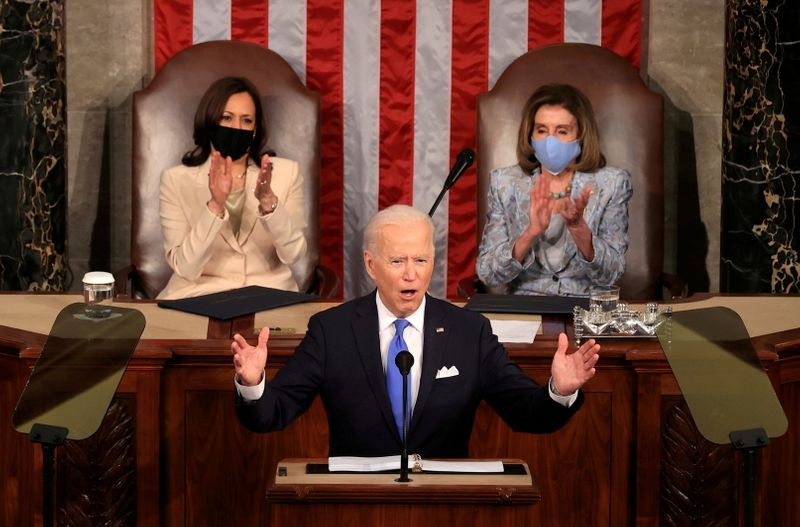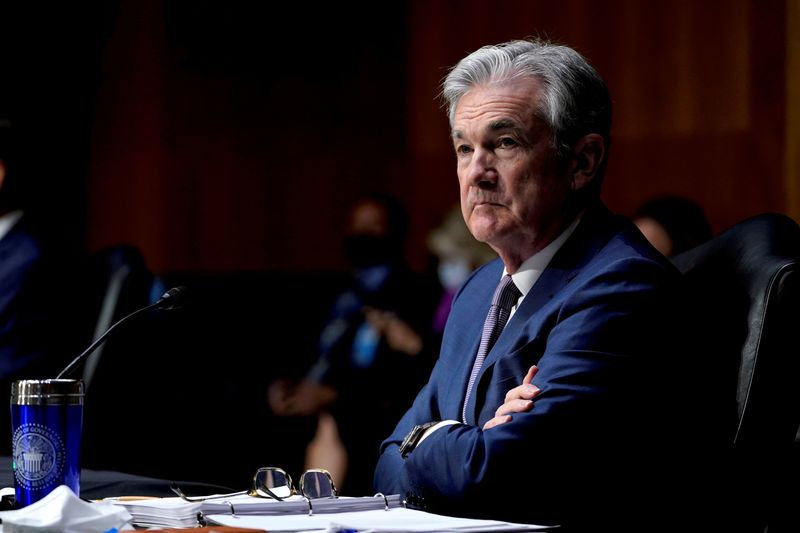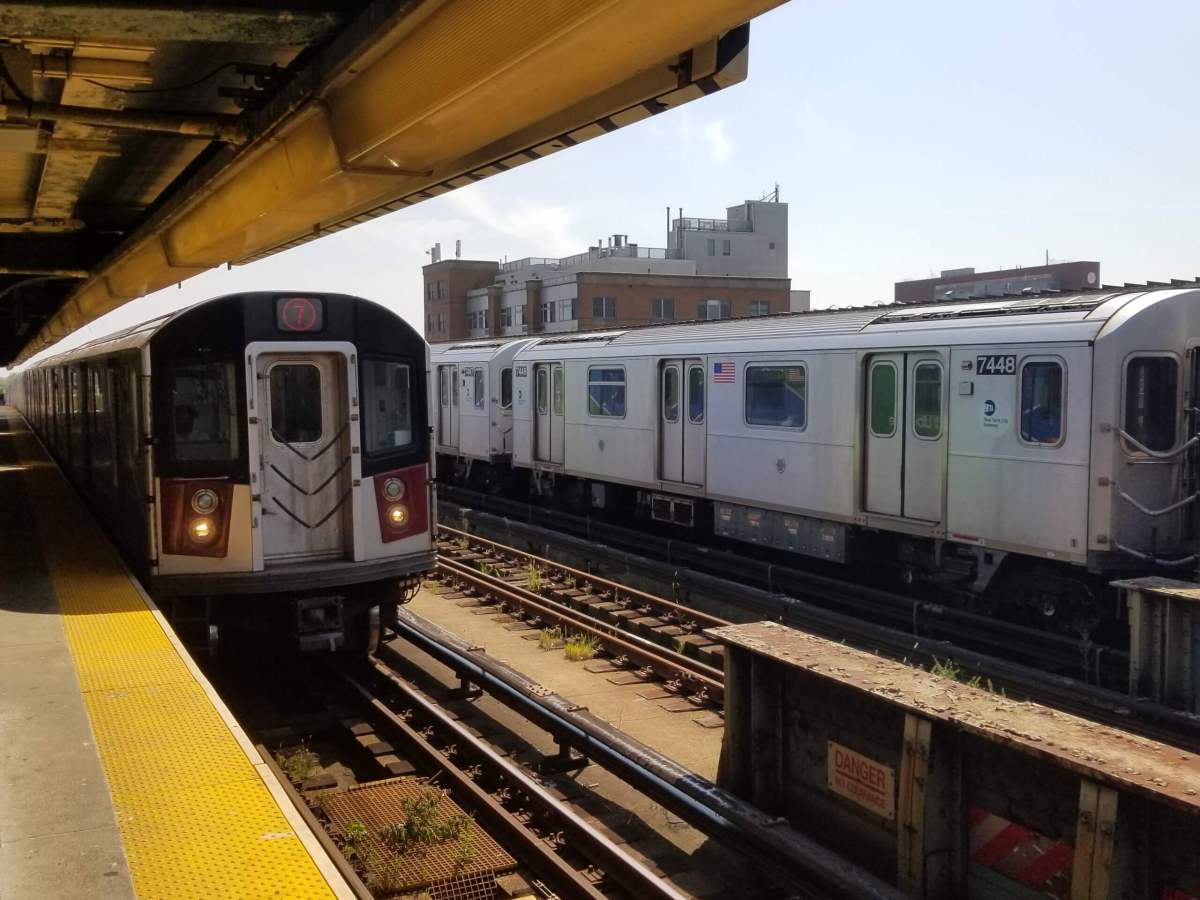WASHINGTON (Reuters) – Within a span of six hours last week, U.S. President Joe Biden and Federal Reserve Chair Jerome Powell embarked on a potentially historic course, pairing massive government spending and ultra-easy monetary policy in an effort not just to rescue the economy from a recession but to reset its trajectory.
Powell’s motivation is to push the limits of a job market rebound as far as possible, a goal that is a step beyond what the U.S. central bank has done before and which he restated Wednesday in an emphatic pledge to get Americans back to work.
For Biden, it’s about putting the federal treasury behind public investment in a way not done since the 1960s with aims at least as ambitious. Addressing a joint session of Congress that evening, the Democratic president argued for filling what he sees as holes in the social safety net, smoothing the edges of the broader labor market to allow people to qualify for and get into jobs more easily, and boosting long-run productivity with updated infrastructure.
There are some close analogies. In the 1970s, the Fed under then-Chair Arthur Burns oversaw a landscape in which interest rates were too low for the inflation pressures building as federal deficits and spending also rose – something he allowed under pressure from President Richard Nixon and which led to a rekindling of price pressures.
For a graphic on Fiscal and monetary pull together:
https://graphics.reuters.com/USA-ECONOMY/SPENDING/jbyprwglkve/chart.png
But there’s no exact parallel to how Biden’s fiscal approach and Powell’s monetary policy have synched up. Neither Burns, who eventually raised rates, or Nixon, who won reelection in 1972 before resigning two years later, had the sort of economic transformation in mind that the current president and Fed chair have set upon from separate directions.
“There is a view that both fiscal and monetary policy were too hawkish for several decades,” leading to lower growth and higher unemployment on average, said Jason Furman, chair of the White House’s Council of Economic Advisers under former President Barack Obama and now a professor at Harvard’s Kennedy School of Government. “The pendulum has shifted really far back in the other direction.”
Biden and Powell are spurred, he said, “by a similar set of views about recent decades and similar interpretation of the data.”
UNEMPLOYMENT BELOW 3%?
Biden’s spending plan would commit about $4 trillion to a combination of infrastructure meant to combat climate change and boost long-run economic growth, and programs to make child care, education and other basics of modern life more affordable for people on the lower rungs of the income ladder.
The proposal, if passed in its current form by Congress, would be the most sweeping federal intervention in the economy since former President Lyndon Johnson’s “Great Society” programs in the 1960s. It also would add to already-record U.S. deficits, and in that regard Biden is like many of his predecessors.
But his proposals still stand out. Deficit increases under Republican presidents have been driven largely by tax cuts, on the theory that money in private hands would be spent and invested more efficiently than by government, and would raise growth and productivity that way.
But the approaches of the two last Democratic presidents were also distinct from Biden. Former President Bill Clinton actually oversaw budget surpluses, while Obama’s spending proposals were aimed at pulling the economy out of the 2007-2009 recession.
Biden, by contrast, has put his faith in government’s ability to fairly allocate capital and expand social programs to make the economy better off over time, and to raise taxes on corporations and the wealthiest Americans to do so.
It isn’t about crisis response – a $1.9 trillion pandemic relief package pushed by the White House was approved last month – as much as about what comes next.
Pointing to innovations from interstate highways to the initial public funding that launched the Internet, Biden told Congress: “These are investments we made together as one country. And investments that only the government was in a position to make. Time and again, they propel us into the future.”
Low interest rates on government debt make Washington’s spending more affordable, and economists expect a sizeable portion of Biden’s spending agenda to pass a Congress that is effectively controlled by Democrats.
Joel Prakken, chief U.S. economist at IHS Markit, said Biden’s plan should push unemployment to near 3% or lower, levels not seen since the early 1950s and below the 3.5% reached just before the pandemic. The jobless rate was 6% in March.
NO ‘BAD OLD DAYS’
The Fed is all in.
Since taking the reins of the central bank in early 2018, Powell has made known his skepticism about some of the key economic models behind Fed policymaking.
He launched an overhaul of the central bank’s policy framework that puts a premium on allowing the economy to find its way to “maximum employment” without prejudging where that would be or worrying that rising employment would trigger inflation.
While the Fed is responsible for keeping inflation at bay, Powell argues it can be newly aggressive in its approach to the labor market without a return to the “bad old days” of accelerating price increases because the economy works differently now than it did when Burns led the central bank.
There is more than a little concern, however, that the current confluence is too reminiscent of that era.
“The whole spirit of the joint fiscal-monetary thrust right now resembles most closely that which fueled the ‘Great Inflation of the 1970s,'” said Peter Ireland, an economics professor at Boston College. “There are immense political and social pressures in our society right now, of the like that haven’t been seen since the 1960s, and they are all pushing us towards higher inflation.”
Fed policymakers remain convinced that’s not going to happen. They have set up a strict, three-part test for raising interest rates – a job market “consistent with” maximum employment, inflation at 2%, and inflation on track to go even higher “for some time” before any Fed policy change – and on Wednesday Powell was adamant he would stick with that formula, however long it takes.
“We’ve still got a lot of people who are out of work,” Powell said in a news conference after the end of the Fed’s latest two-day policy meeting. “We want to get them back to work as quickly as possible, and that’s really one of the things we’re trying to achieve.”
(Reporting by Howard Schneider; Editing by Dan Burns and Paul Simao)

























